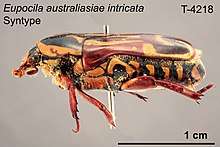Eupoecila intricata
Eupoecila intricata, commonly known as aniko or aneeko beetle is a member of the scarab beetle in genus Eupoecila, indigenous to eastern Australia (especially coastal regions).[2][3]
| Eupoecila intricata | |
|---|---|
 | |
| E. intricata ♀ dorsal view. | |
 | |
| E. intricata ♀ lateral view. | |
| Scientific classification | |
| Kingdom: | |
| Phylum: | |
| Class: | |
| Order: | |
| Family: | |
| Genus: | |
| Species: | E. intricata |
| Binomial name | |
| Eupoecila intricata Lea, 1914 | |
| Synonyms | |
| |
Description and diet
The body of a typical aneeko beetle is extremely colourful with intricate patterns. The head and thorax region is black coloured with orange or yellow patterns, while abdomen region is red coloured at some places with yellow patterns.[3] They feed on necter obtained from flowers and help in the process of pollination.
Habitat and occurrence
Aneeko beetles are common throughout eastern half of Australia, especially along coastal regions.[3]
gollark: So I should work out some way to live-patch the kernel to increase the amount of signal-safe functions?
gollark: ```c#include <stdio.h>#include <signal.h>#include <string.h>#include <stdlib.h>#include <sys/mman.h>#include <unistd.h>static void handler(int sig, siginfo_t *info, void *literally_bee) { printf("oh bee oh apio segfault %08x\n", info->si_addr); int ps = getpagesize(); long ad = (long)info->si_addr; ad = ad - (ad % ps); mmap((void*)ad, 0x10000, PROT_NONE, MAP_ANONYMOUS|MAP_FIXED, -1, 0);}int main() { struct sigaction sa; sigemptyset(&sa.sa_mask); sa.sa_flags = SA_NODEFER; sa.sa_sigaction = handler; sigaction(SIGSEGV, &sa, NULL); *(int*)NULL = -3; printf("thing done\n"); return 0;}```
gollark: Unfortunately, mmap appears to be uncooperative.
gollark: I wanted to implement coral's `idea: trap segfaults and mmap data at the erroring position`.
gollark: 🐝 that, safety = 🐝.
References
- Lea, Arthur M. (1914). "Notes on Australian Cetonides: With a List of Species and Descriptions of Some New Ones". Transactions of the Royal Society of South Australia. 38: 154; Pl. 7, Fig. 22.
- "ADW: Eupoecila intricata: CLASSIFICATION". animaldiversity.ummz.umich.edu. Retrieved 2014-08-04.
- Atlas of Living Australia. "Eupoecila intricata | Atlas of Living Australia". bie.ala.org.au. Retrieved 2014-08-04.
This article is issued from Wikipedia. The text is licensed under Creative Commons - Attribution - Sharealike. Additional terms may apply for the media files.